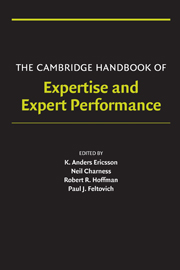Book contents
- Frontmatter
- Contents
- Acknowledgments
- Contributors
- PART I INTRODUCTION AND PERSPECTIVE
- PART II OVERVIEW OF APPROACHES TO THE STUDY OF EXPERTISE – BRIEF HISTORICAL ACCOUNTS OF THEORIES AND METHODS
- PART III METHODS FOR STUDYING THE STRUCTURE OF EXPERTISE
- PART IV METHODS FOR STUDYING THE ACQUISITION AND MAINTENANCE OF EXPERTISE
- PART V DOMAINS OF EXPERTISE
- PART V.A PROFESSIONAL DOMAINS
- 19 Expertise in Medicine and Surgery
- 20 Expertise and Transportation
- 21 Expertise in Software Design
- 22 Professional Writing Expertise
- 23 Professional Judgments and “Naturalistic Decision Making”
- 24 Decision-Making Expertise
- 25 The Making of a Dream Team: When Expert Teams Do Best
- PART V.B ARTS, SPORTS, & MOTOR SKILLS
- PART V.C GAMES AND OTHER TYPES OF EXPERTISE
- PART VI GENERALIZABLE MECHANISMS MEDIATING EXPERTISE AND GENERAL ISSUES
- Author Index
- Subject Index
- References
20 - Expertise and Transportation
from PART V.A - PROFESSIONAL DOMAINS
- Frontmatter
- Contents
- Acknowledgments
- Contributors
- PART I INTRODUCTION AND PERSPECTIVE
- PART II OVERVIEW OF APPROACHES TO THE STUDY OF EXPERTISE – BRIEF HISTORICAL ACCOUNTS OF THEORIES AND METHODS
- PART III METHODS FOR STUDYING THE STRUCTURE OF EXPERTISE
- PART IV METHODS FOR STUDYING THE ACQUISITION AND MAINTENANCE OF EXPERTISE
- PART V DOMAINS OF EXPERTISE
- PART V.A PROFESSIONAL DOMAINS
- 19 Expertise in Medicine and Surgery
- 20 Expertise and Transportation
- 21 Expertise in Software Design
- 22 Professional Writing Expertise
- 23 Professional Judgments and “Naturalistic Decision Making”
- 24 Decision-Making Expertise
- 25 The Making of a Dream Team: When Expert Teams Do Best
- PART V.B ARTS, SPORTS, & MOTOR SKILLS
- PART V.C GAMES AND OTHER TYPES OF EXPERTISE
- PART VI GENERALIZABLE MECHANISMS MEDIATING EXPERTISE AND GENERAL ISSUES
- Author Index
- Subject Index
- References
Summary
There are more expert drivers in the United States than any other type of expert. A 35-year-old Los Angelino who commutes an hour to work and travels only minimally on weekends will have spent over 10,000 hours behind the wheel, a number sometimes held up as a threshold for expertise (Chase & Simon, 1973). If, however, instead of a time-based definition, one takes as the criterion for expertise performing a task better than someone with less experience, then our opening assertion about expert drivers in the United States is less apparent.
In the transportation domain, defining expertise in any absolute sense is nontrivial. Self-evaluations, as is often the case, place most drivers as above average (Waylen, Horswill, Alexander, & McKenna, 2004) and are at best weakly correlated with evalua tions of a driving instructor (Groeger & Grande, 1996). If we searched the literature for “highly experienced” operators back to the turn of the last century, we would find a plethora of transportation studies, but they would not inform modern notions of expertise.
Instead, we chose to look at relative differences in experience. Table 20.1 details the participant characteristics for a number of the studies reviewed here, along with one modern-day classification scheme (Hoffman, 1996). Expertise is usually defined by number of years operating the vehicle, or miles driven, or hours flown by the operator. Table 20.2 shows a variety of comparisons in relative experience.
- Type
- Chapter
- Information
- The Cambridge Handbook of Expertise and Expert Performance , pp. 355 - 372Publisher: Cambridge University PressPrint publication year: 2006
References
- 14
- Cited by



